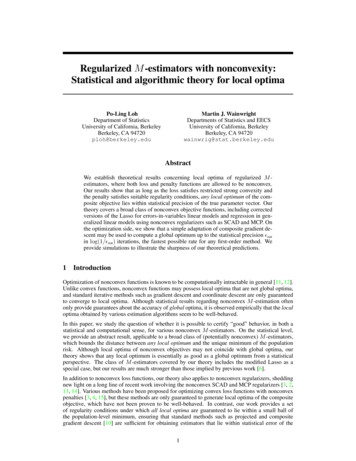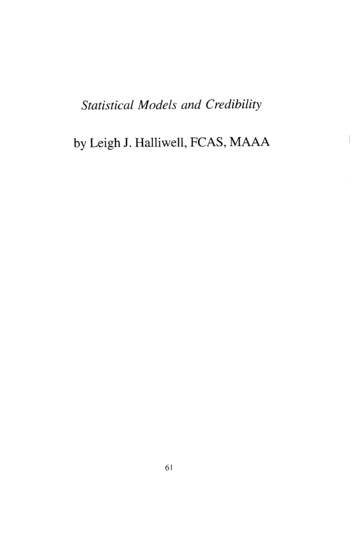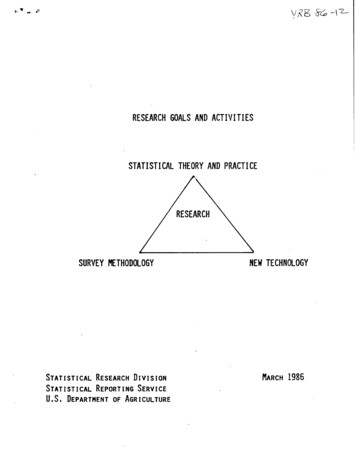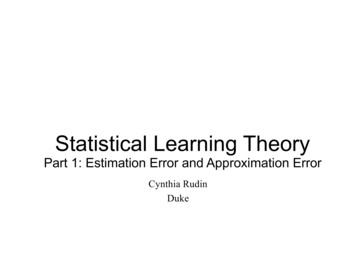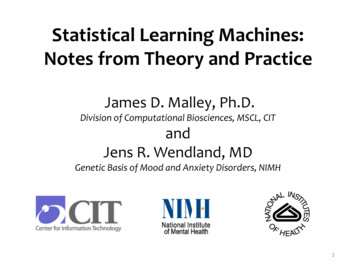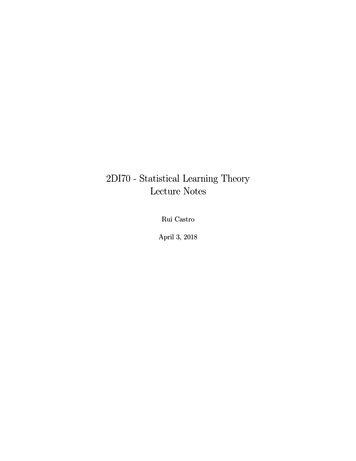
Transcription
2DI70 - Statistical Learning TheoryLecture NotesRui CastroApril 3, 2018
Some of the material in these notes will be published by Cambridge University Press asStatistical Machine Learning: A Gentle Primer by Rui M. Castro and Robert D. Nowak. Thisearly draft is free to view and download for personal use only. Not for re-distribution, re-sale oruse in derivative works.c Rui M. Castro and Robert D. Nowak, 2017.2
ContentsContents1 Introduction1.1 Learning from Data . . . . . .1.1.1 Data Spaces . . . . . . .1.1.2 Loss Functions . . . . .1.1.3 Probability Measure and1.1.4 Statistical Risk . . . . .1.1.5 The Learning Problem .2. . . . . . . . . . . . . . . . . . . . . .Expectation. . . . . . . . . . . . . . .2 Binary Classification and Regression2.1 Binary Classification . . . . . . . . .2.2 Regression . . . . . . . . . . . . . . .2.3 Empirical Risk Minimization . . . .2.4 Model Complexity and Overfitting .2.5 Exercises . . . . . . . . . . . . . . .99910111112.1515181921253 Competing Goals: approximation vs. estimation3.1 Strategies To Avoid Overfitting . . . . . . . . . . .3.1.1 Method of Sieves . . . . . . . . . . . . . . .3.1.2 Complexity Penalization Methods . . . . .3.1.3 Hold-out Methods . . . . . . . . . . . . . .29303132334 Estimation of Lipschitz smooth functions4.1 Setting . . . . . . . . . . . . . . . . . . . .4.2 Analysis . . . . . . . . . . . . . . . . . . .4.2.1 Empirical Risk Minimization . . .4.2.2 Approximation Error . . . . . . . .4.2.3 Estimation Error . . . . . . . . . .4.3 Exercises . . . . . . . . . . . . . . . . . .373739404142445 Introduction to PAC learning5.1 PAC bounds . . . . . . . . . . . . . . . . . . . . . . . . . . . . .5.1.1 A Simple PAC bound in the binary classification setting5.2 Agnostic Learning and general PAC bounds . . . . . . . . . . .5.2.1 Empirical Risk Minimization - How good is it? . . . . .4950515353.3.
5.35.4Constructing uniform deviation bounds . . . . . . . . . . . . . . . . . . . . . . .Exercises . . . . . . . . . . . . . . . . . . . . . . . . . . . . . . . . . . . . . . . .6 Concentration Bounds6.1 Markov and Chebyshev’s inequalities . . . . .6.2 A basic concentration inequality for averages6.3 Chernoff bounding and Hoeffding’s inequality6.4 Exercises . . . . . . . . . . . . . . . . . . . .5454.57575859657 General bounds for bounded losses7.1 Bounded Loss Functions . . . . . . . . . . . . . . . . . .7.2 Expected Risk Bounds for Empirical Risk Minimization7.3 A PAC-bound for empirical risk minimization . . . . . .7.4 Application: the histogram classifier . . . . . . . . . . .7.5 Exercises . . . . . . . . . . . . . . . . . . . . . . . . . .6969717373758 Countably Infinite Model Spaces8.0.1 A Special Case - F finite . . . . . . . . . .8.1 Choosing the values c(f ) . . . . . . . . . . . . . . .8.2 The Kraft Inequality . . . . . . . . . . . . . . . . .8.2.1 Application - Structural Risk Minimization8.3 Complexity Regularization Bounds . . . . . . . . .777979808183Histogram Classifier revisitedComplexity regularization . . . . . . . . . . . . . . . . . . . . . . . . . . . . . . .Leave-one-out Cross Validation . . . . . . . . . . . . . . . . . . . . . . . . . . . .Exercises . . . . . . . . . . . . . . . . . . . . . . . . . . . . . . . . . . . . . . . .858588919 The9.19.29.3.10 Decision Trees and Classification10.1 Penalized Empirical Risk Minimization . . . . . . . . . . . . . . . .10.2 Binary Classification . . . . . . . . . . . . . . . . . . . . . . . . . .10.2.1 Empirical Classifier Design . . . . . . . . . . . . . . . . . .10.3 Binary Classification Trees . . . . . . . . . . . . . . . . . . . . . . .10.3.1 Growing Trees . . . . . . . . . . . . . . . . . . . . . . . . .10.3.2 Pruning . . . . . . . . . . . . . . . . . . . . . . . . . . . . .10.4 Comparison between Histogram Classifiers and Classification Trees10.4.1 Histogram Risk Bound . . . . . . . . . . . . . . . . . . . . .10.4.2 Dyadic Decision Trees . . . . . . . . . . . . . . . . . . . . .10.5 Final Comments and Remarks for Implementation . . . . . . . . .10.6 Exercises . . . . . . . . . . . . . . . . . . . . . . . . . . . . . . . .10.7 Appendix: abbreviated solution of Exercise 10.6.2 . . . . . . . . . .10.8 Appendix: Box Counting Dimension . . . . . . . . . . . . . . . . .9595969798989910010110310410510911111 Vapnik-Chervonenkis (VC) Bounds11311.1 Two Ways to Proceed . . . . . . . . . . . . . . . . . . . . . . . . . . . . . . . . . 11311.2 Vapnik-Chervonenkis Theory . . . . . . . . . . . . . . . . . . . . . . . . . . . . . 11411.3 The Shatter Coefficient and the Effective Size of a Model Class . . . . . . . . . . 1174
11.4 Linear Classifiers . . . . . . . . . . .11.5 Generalized Linear Classifiers . . . .11.6 Decision Trees . . . . . . . . . . . . .11.7 Structural Risk Minimization (SRM)11.8 Application to Trees . . . . . . . . .11.9 Appendix: Proof of Theorem 11.3.1 .11.10Exercises . . . . . . . . . . . . . . .12 Denoising of Piecewise Smooth Functions12.1 Noisy observations . . . . . . . . . . . . .12.2 Estimation . . . . . . . . . . . . . . . . .12.3 Piecewise Smooth Functions . . . . . . . .12.3.1 Recursive Dyadic Partitions . . . .12.3.2 Performance . . . . . . . . . . . .12.4 Final Remarks . . . . . . . . . . . . . . .12.5 Exercises . . . . . . . . . . . . . . . . . .5.119119121122124124129.133133133134135138140142
6
AbstractThese notes are work in progress, and are being adapted from lecture notes from a course theauthor taught at Columbia University. These are based on various materials, and in particularnotes developed during a reading group in the University of Wisconsin - Madison (which wascoordinated by Robert Nowak). Any comments and remarks are most welcome. The authorwants to thank Ervin Tánczos and Sándor Kolumbán for helping in the revision of the notesand the correction of typos. Naturally, the author of the current version is the sole responsiblefor the errors it contains.7
8
Chapter 1IntroductionIn this chapter we give a very short introduction of the elements of statistical learning theory,and set the stage for the subsequent chapters. We take a probabilistic approach to learning, asit provides a good framework to cope with the uncertainty inherent to any dataset.1.1Learning from DataWe begin with an illustrative example.Example 1.1.1 (Classification of hand-written digits) A classical problem in machine learning is the automated classification of handwritten digits. The main goal is to construct a classifier(that is, a function) that takes an image of an handwritten digit (e.g., a 128 128 pixel image)and outputs the corresponding digit (e.g., 0, 1, 2, . . . , 9). Obviously this is not such an easy task,as different persons have different styles of writing, and there are digits that are remarkablysimilar (e.g., 1 and 7 or 4 and 9). The supervised learning approach to this problem is to takea large set of labeled example (pairs of handwritten digits and the corresponding digit, annotatedby an expert) and use this dataset to automatically construct a classifier that generalizes well meaning, it works well in examples outside the dataset.The typical architecture of such a system goes as follows. The raw data (and image, avideo sequence, etc.) is first pre-processed in a smart way to extract important features (e.g.,extract the salient edges from the handwritten digit images). This is then used for classification/regression. It is the last step we are mostly concerned with. In recent years, and in lightof the advances in computational power, it is possible to “feed” the classifiers with the raw data,and learn what features are most useful - in what is generically known as “deep learning”.To formulate the basic learning from data problem, we must specify several basic elements:data spaces, probability measures, loss functions, and statistical risk.1.1.1Data SpacesFrom this point on we assume the raw data has been possibly processed, and this is what wehave available. Learning from data begins with a specification of two spaces:X Input Space9
Y Output SpaceThe input space is also sometimes called the “feature space” or “signal domain”. In statisticsand regression models this is referred to as the space of covariates. The output space is alsocalled the “label space”, “outcome space”, “signal range”, or in statistical regression the responsespace.Example 1.1.2 X [0, 1]128 128 and Y {0, 1, . . . , 9} fit the example above, where the inputspace indicates is that of grayscale handwritten images and the output space is that of digits.Example 1.1.3 X R is a one-dimensional signal domain (e.g., time domain) and Y Rcorresponds to a real valued signal. A classical example is the estimation of a signal f in noise,using dataYi f (Xi ) Wi ,where {(Xi , Yi )}ni 1 is our training data, Wi corresponds to some additive noise, and f is thesignal we would like to estimate.1.1.2Loss FunctionsSince we are trying to predict/classify labels we need to measure the performance of our learnerin some way. Suppose we have a true label y Y and a label prediction ŷ Y. A loss functionmeasures how “different” are these two quantities. Formally, a loss function is a map :Y Y RExample 1.1.4 In binary classification problems, Y {0, 1}. The 0/1 loss function is a popularchoice. (ŷ, y) 1{ŷ 6 y} ,where 1{A} is the indicator function which takes a value of 1 if the logical condition A is trueand zero otherwise. We typically will compare a true label y with a prediction ŷ, in which case the0/1 loss simply counts misclassifications. Note this is a symmetric function in the arguments,so the two possible types of errors have the same weight. Sometimes, this is not adequate, as inthe next example.Example 1.1.5 (Spam email classification) When classifying spam emails one is much moreinclined to tolerate a few misses (i.e., classifying a spam email as legit), than incurring falsealarms (i.e., classifying legit emails as spam). Therefore, the typical loss function in this caseis not symmetric, but rather something like 51 (ŷ, y) 0if ŷ 1, y 0if ŷ 0, y 1otherwise,where label 0 and 1 correspond to legit and spam email, respectively.10
Example 1.1.6 In regression or estimation problems, Y R. The squared error loss functionis often employed. (ŷ, y) (ŷ y)2 .This function is symmetric in the arguments, and has many practical and theoretical advantages- it is continuous, infinitely differentiable and convex on both arguments. It also provides anatural way to compare an estimate ŷ with the true value y that penalizes big differences betweenthe two.The loss function can be used to measure the “risk” of a learning rule. It is, however, notimmediately clear how to do so. Measuring the loss incurred on the training dataset is notparticularly useful if one is trying to characterize the performance in test examples that arenot part of the training set. This is where probability comes to the rescue, and provides aninteresting framework to cast our problem.1.1.3Probability Measure and ExpectationDefine a joint probability distribution on X Y denoted PXY . Let (X, Y ) denote a pair ofrandom variables distributed according to PXY . This distribution can alternatively be describedby the marginal distribution of X and the conditional distribution of Y given X (sometimesthis description is more convenient) — let PX denote the marginal distribution on X, and letPY X denote the conditional distribution of Y given X. For any distribution P , let p denote itsdensity function with respect to the corresponding dominating measure; e.g., Lebesgue measurefor continuous random variables or counting measure for discrete random variables.Finally define the expectation operator asZZE[f (X, Y )] f (x, y)dPXY (x, y) f (x, y)pXY (x, y)dxdy .Later we will assume our training data is an independent and identically distributed samplefrom such distributions. This captures the idea that features and labels are related somehow, butthere is some uncertainty. Furthermore, since we assume the training examples are independent,this means that information from one training example does not help us to predict the otherexamples if we already know PXY .Remark 1.1.1 Whenever clear from the context we will drop the subscripts in this notation.For instance PY X (Y 1 X x) P(Y 1 X x).1.1.4Statistical RiskThe basic problem in learning is to determine a mapping f : X Y that takes an input x Xand predicts the corresponding output y Y as well as possible. A way to measure the risk isto assume that a pair feature/label comes from the distribution PXY and see how the learningrule does on average. This gives rise to the notion of statistical riskDefinition 1.1.1 (Statistical Risk) For a prediction rule f and a joint distribution of featuresand labels PXY the statistical risk of f is defined asR(f ) E [ (f (X), Y ) f ] ,11
where (X, Y ) PXY . The conditional statement is there to ensure the definition is sensible evenif f is a random quantity.The risk tells us how well, on average, the predictor f performs with respect to the chosenloss function. To judge the performance of a particular learning rule, it makes sense to compareit to the best possible learning rule. Hence the minimum risk value is a key quantity of interest.It is defined asR infR(f )f measurablewhere the infimum is taking over all measurable functions (meaning these are nice functionswhere you can compute the expectation).1.1.5The Learning ProblemWe now have all the ingredients to formulate the learning problem. Suppose we are asked toconstruct a prediction rule that has good performance for the labeled example (X, Y ) distributedaccording to PXY ((X, Y ) PXY for short). Our goal is to find a map f so that f (X) Ywith high probability. Ideally, we would choose f to minimize the risk R(f ) E[ (f (X), Y )].However, in order to compute the risk (and hence optimize it) we need to know the jointdistribution PXY . In many problems of practical interest, the joint distribution is unknown, anddirectly minimizing the risk is not possible. What can we do then? We can try to learn a goodprediction rule f by using training data!Suppose we have a training dataset, that is, a collection of labeled examples we can use tofind a good prediction rule that works for examples we have not seen yet. Here we are goingto make what is, perhaps, the strongest assumption of this setting. Let’s assume the trainingexamples are samples from the unknown distribution PXY . Specifically, suppose you are given nsamples {Xi , Yi }ni 1 independently and identically distributed (i.i.d.) according to the otherwiseunknown distribution PXY . These are called training data. For simplicity, denote this collectionby Dn {Xi , Yi }ni 1 .Are these reasonable assumptions? In many cases yes. Consider for instance the exampleof classification of handwritten digits. Suppose you have a very big “bag” containing all thehandwritten doodles of digits that you might ever observe. Obviously we do not have assessto this, but only a sample of the elements in the bag. This sample is your training set. Ifthese digits come from different people (chosen randomly) then the i.i.d. assumption is not sofar-fetched.The independence between the samples captures the idea that these come from differentsources, and that these do not carry information about each other if we have access to PXY .The identically distributed assumption captures the idea that these are somehow a representativesample of the type of instances we might encounter in the future. In the context of handwrittendigit classification independence captures the notions that our dataset consists of digits writtenby different people at different times, and identically distributed samples means that we’ll usethe learned rule to classify similar types of handwritten digits. This assumption would beunreasonable if our training set consisted mainly of male writers, and we want to use the learnedrule for female writers.Suppose we have a class of candidate prediction rules F (e.g., linear classifiers, neural networks, etc.). Our goal is to use the training data Dn to choose a mapping out of F that is,12
hopefully, a good one. Formally, we want to choose a map fˆn F. It is important to note thatthe selected model fˆn is a function of the training datafˆn (x) f (x; Dn ) .The subscript symbol n denotes the dependence on the training set size, and the “hat” indicatesthis is a function of the training dataset. This is to avoid having to represent this dependenceexplicitly so that we avoid unnecessary notational clutter. Note that fˆn is a random function(since it is a function of Dn , which is a random vector).How do we measure the performance of this rule? Again, our assumptions come to the rescue.Suppose there is another instance (X, Y ) PXY , but only the feature part X is revealed to us this is what is known as a test example. Can we predict Y well using our learned rule? In otherwords, is (fˆn (X), Y ) small? We would like this to be small regardless of which test example weget. This is typically not possible, but we can maybe say the loss is small on average, or it issmall “most of the times”. Let’s try to formalize this notion.Recall that the statistical risk of fˆn is defined ashiR(fˆn ) E (fˆn (X), Y ) fˆn .Note that, R(fˆn ) in this definition is still a random quantity (since it is a function of fˆn , whichis a function of Dn ). A different way to write this risk is ashiR(fˆn ) EXY (fˆn (X), Y ) ,where the expectation is taken only with respect to X and Y . This notation is sometimes usefulto understand the concepts, but it can easily lead to problems in more complicated settings, sowe will avoid it as much as possible, and use only the notation of conditional expectations1 .Most of the material in these notes is concerned with the study of the risk as defined above.Namely we are interested in guaranteeing that R(fˆn ) is small with very high probability overthe distribution of the training data (again, recall that R(fˆn ) is a random variable). Sometimeswe will be content in guaranteeing the expected risk is small, computed over random realizationsof the training data.Definition 1.1.2 (Expected Risk) The expected risk of a prediction rule is given by E[R(fˆn )].Note that, the expectation is over the training data and any randomized choices of the learningalgorithm.Our hope is that fˆn has a small expected risk, given enough training data. The notionof expected risk can be interpreted as follows: we would like to define an algorithm (a modelselection process) that performs well on average, over any random sample of n training data.The expected risk is a measure of the expected performance of the algorithm with respect tothe chosen loss function. That is, we are not gauging the risk of a particular map f F, butrather we are measuring the performance of the algorithm that takes any realization of training1Let X and Y be random variables. The notation E[Y X] indicates a conditional expectation, the expectationof Y given X, therefore this is a random variable, in fact E[Y X] g(X) for some function g. A very importantfact is that the expectation of a conditional expectation removes the conditioning. That is E[E[Y X]] E[Y ].This is known as the law of total expectation, and we will use it often.13
data {Xi , Yi }ni 1 and selects an appropriate model in F. In other words, we are studying theperformance of algorithms, not of specific prediction rules that were derived from the data.Perhaps surprisingly, we can make main statements in this regard without making any assumptions about PXY . So the data can be produced by ANY distribution whatsoever! Themain challenges concern with the choice of “good” spaces of prediction rules F and how can wedesign useful and effective model selection algorithms, as we will see in the subsequent chapters.14
Chapter 2Binary Classification and RegressionIn this chapter we will consider two specific settings that are very commonly used, namely binaryclassification and regression. This will help you to get a good grip of the basic concepts. Recallthat the our goal is to use training data to learn a prediction rule, that is, a map from thefeature space X , to a label space Y.2.1Binary ClassificationThis is, in a sense, the simplest type of classification problem, where we have only two possiblelabels. This is actually a very common setting. For instance, emails can be classified as legitor spam. A patient in an hospital is either healthy or sick, etc. In all these scenarios we canabstract the possible labels as Y {0, 1}, so this will be the label space in this section. Thefeature space obviously depends on the specific problem. For spam filtering it might be a bagof-words, for the patient diagnosis it might be a collection of measurements collected by doctors(e.g., heart rate, blood pressure, presence of specific symptoms). For concreteness let’s considerthat the feature space is a subset of Rd (although this is not so important in what follows).Finally, let’s consider the familiar 0/1 loss function (ŷ, y) 1{ŷ 6 y} 10if ŷ 6 yif ŷ y.In this setting a prediction rule f is generally referred to as a classification rule. Recall thatthe risk of any prediction rule is defined simply as the expected value of the loss function for anexample (X, Y ) PXY ,R(f ) E [ (f (X), Y )] E [1{f (X) 6 Y }] P(f (X) 6 Y ) .So the risk based on the 0/1 loss function is simply the probability of making errors. This is quitea natural way to measure performance of classifiers. Note that in the above we are assumingf is not random, without loss of generality (otherwise you need to include a conditioning on f ,which will only overburden the notation).Naturally we would like to compare the performance of a classifier to that of the best possible classifier (as we cannot hope to do better than this), given the knowledge of PXY . Theperformance of the best classification rule is known as the Bayes Risk.15
Definition 2.1.1 The Bayes risk is the infimum of the risk for all classifiersR inff measurableR(f ) .For the classification setting described above we can actually explicitly describe a classifierthat attains the Bayes risk, known as the Bayes classifier.Definition 2.1.2 (Bayes Classifier) The Bayes classifier is the following mapping: 1 if η(x) 1/2 f (x) 1{η(x) 1/2} ,0 otherwisewhereη(x) PY X (Y 1 X x)is called the feature conditional probability.This is actually quite intuitive. If, for a given that X x, you know that the probability thatY 1 is larger than that of Y 0 you should predict the label is actually 1, and vice-versa. Sothe Bayes classifier predicts Y 1 if P(Y 1 X x) P(Y 0 X x), and zero otherwise.We are ready to state our first result.Proposition 2.1.1 The Bayes classifier attains the Bayes risk, namelyR(f ) R .Proof Let g : X Y be any classifier. We will show that R(g) R(f ) 0. This implies thatno classifier can better than the Bayes classifier, therefore, it attains the minimum risk. NotethatR(g) R(f ) P(g(X) 6 Y ) P(f (X) 6 Y )Z (P(g(X) 6 Y X x) P(f (X) 6 Y X x)) dPX (x) .XWe will show thatP(g(X) 6 Y X x) P(f (X) 6 Y X x) 0 ,which implies immediately that R(g) R(f ) 0. For any classifier gP(g(X) 6 Y X x) P (Y 1, g(X) 0 X x) P (Y 0, g(X) 1 X x) E[1{Y 1}1{g(X) 0} X x] E[1{Y 0}1{g(X) 1} X x] 1{g(x) 0}E[1{Y 1} X x] 1{g(x) 1}E[1{Y 0} X x] 1{g(x) 0}P(Y 1 X x) 1{g(x) 1}P(Y 0 X x) 1{g(x) 0}η(x) 1{g(x) 1}(1 η(x)) 1{g(x) 0}(2η(x) 1) (1 η(x)) ,16(2.1)
where the last equality follows by noting that 1{g(x) 0} 1 1{g(x) 1}. The aboveequality makes it easy to write the difference between the conditional probability of error ofclassifier g and the Bayes classifer.P(g(X) 6 Y X x) P(f (X) 6 Y X x) 1{g(x) 0}(2η(x) 1) (1 η(x)) [1{f (x) 0}(2η(x) 1) (1 η(x))] 1{g(x) 0}(2η(x) 1) 1{f (x) 0}(2η(x) 1) (1{f (x) 1} 1{g(x) 1}) (2η(x) 1) .We are almost done. Recall that the Bayes classifier predicts label one if η(x) 1/2 and zerootherwise. Therefore, if x is such that η(x) 1/2 we have 1{f (x) 1} 1{g(x) 1} · (2η(x) 1) 0 .{z} {z} {z} 10 or 1 0{z} 0Analogously, if x is such that η(x) 1/2 we have 1{f (x) 1} 1{g(x) 1} · (2η(x) 1) 0 . {z} {z} {z}00 or 1 0 {z} 0So, regardless of the value of x we conclude thatP(g(X) 6 Y X x) P(f (X) 6 Y X x) (1{f (x) 1} 1{g(x) 1}) (2η(x) 1) 0 .Plugging in this in (2.1) concludes the proof. Note that while the Bayes classifier achieves the Bayes risk, this rule needs the knowledge ofthe joint distribution of (X, Y ), that is not generally available to us.It is also interesting and useful to write the excess risk R(g) R using (2.1).Lemma 2.1.1 Any classifier g : X Y can be written as g(x) 1{x G} for some set G.Let G {x X : η(x) 1/2} be the set corresponding to the Bayes’ classifier. The excess riskis given byZR(g) R G G 2η(x) 1 dPX (x) ,where G G (G Ḡ ) (Ḡ G ) is the symmetric set difference between the sets G and G .Proof From (2.1) we haveR(g) R ZZX ZX (1{f (x) 1} 1{g(x) 1}) (2η(x) 1)dPX (x) 2η(x) 1 1{f (x) 1} 1{g(x) 1} dPX (x) 2η(x) 1 1{f (x) 6 g(x)}dPX (x)ZX G G 2η(x) 1 dPX (x) . 17
In words, the excess risk involves only the subset of the feature space X where the two rules, gand f , disagree (in logic terms this is an exclusive-or).Example 2.1.1 Suppose PX is the uniform distribution in the interval [0, 4] and that 0if 0 x 1 0.3 if 1 x 2η(x) .0.5 if 2 x 3 1if 3 x 4The Bayes classifier is simply f (x) 1{x 2} (note that the Bayes classifier never dependson the marginal distribution of the features PX ). Now consider the classifier g(x) 1{x 3}.This classifier has actually the same risk as the Bayes classifier (why?).Consider also the classifier h(x) 1{x 1}. The excess risk of this classifier isZ 2η(x) 1 dPX (x)R(h) R H G Z 21 2η(x) 1 dx41Z 210.4 dx 0.1 , 41where H [1, 4] and G [2, 4].2.2RegressionThe goal of statistical learning is to construct a prediction mapping from the input space Xto the output space Y, using training data. In regression this prediction rule is often called anestimator or regression function. For concreteness, take X Rd and Y R, and consider thesquared loss function (ŷ, y) (ŷ y)2 .Recalling that the risk is defined to be the expected value of the loss function, we have R(f ) E [ (f (X), Y ) f ] E (f (X) Y )2 f .As we did for classification, it is important to understand what is the minimum risk we canhope for, that is, R inf f R(f ). Below we assume f is deterministic, so that we do not needto condition on f (just as we did in the previous section). We have the following result.Proposition 2.2.1 (Minimum Risk under Squared Error Loss (MSE))Define f (x) E[Y X x] (this is called the regression function). Then this prediction rulehas the smallest possible risk, that isR(f ) R .In addition, the excess risk of any rule f : X Y is given by R(f ) R E (f (X) f (X))2 E (f (X) E[Y X])2 .18
Proof Let f : X Y be any prediction rule (without loss of generality assume it is not random).We have R(f ) E (f (X) Y )2 E E (f (X) Y )2 X E E (f (X) E[Y X] E[Y X] Y )2 Xh E E[(f (X) E[Y X])2 X]i 2E [(f (X) E[Y X])(E[Y X] Y ) X] E[(E[Y X] Y )2 X]h E E[(f (X) E[Y X])2 X]i 2(f (X) E[Y X]) 0 E[(E[Y X] Y )2 X] E (f (X) E[Y X])2 R(f ) . {z} 0Thus R(f ) R(f ) for any prediction rule f , and therefore R R(f ). The second statementin the proposition follows naturally from the last equality. 2.3Empirical Risk MinimizationNow that we have a good working knowledge of the notions of risk, Bayes risk, and so on, wewould like to figure out how to use data to choose a good prediction rule. A natural way to dothis is to use the performance on the training data as a surrogate for the performance for unseendata, leading naturally to the notion of empirical risk.i.i.d.Definition 2.3.1 (Empirical Risk) Let {Xi , Yi }ni 1 PXY be a collection of training data.Then the empirical risk is defined asnR̂n (f ) 1X (f (Xi ), Yi ) .ni 1An interpretation of the empirical risk, is that it is the risk when considering the empiricaldistribution of the data as a surrogate for the true distribution. By the law of large numbersyou know that, for any fixed prediction rule f the empirical risk R̂n (f ) will converge to thetrue risk R(f ) (in a stochastic sense). Therefo
In this chapter we give a very short introduction of the elements of statistical learning theory, and set the stage for the subsequent chapters. We take a probabilistic approach to learning, as it provides a good framework to cope with the uncertainty inherent to any dataset. 1.1





